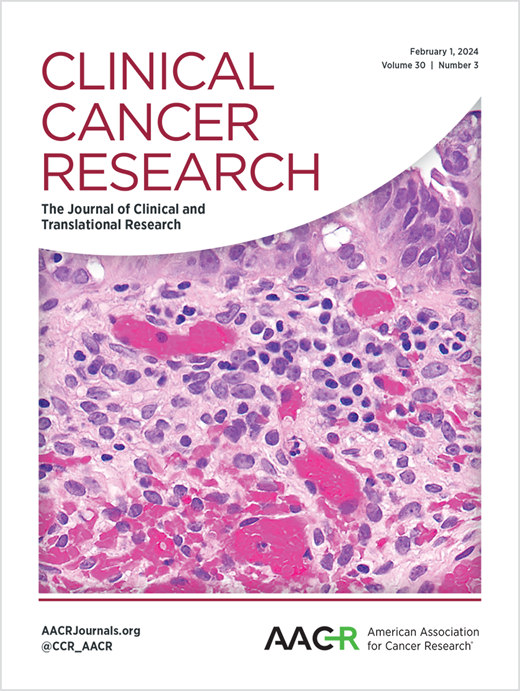基于定量和形态学的深度卷积神经网络方法用于预测新辅助治疗和转移性骨肉瘤的生存率
IF 10
1区 医学
Q1 ONCOLOGY
引用次数: 0
摘要
目的:在新辅助治疗中使用病理切片审查进行坏死量化是传统骨肉瘤最重要的有效预后标志。在此,我们探索了三种针对组织学样本的深度学习策略,以预测新辅助治疗中骨肉瘤的预后。实验设计:我们的研究依赖于纽约大学(纽约州纽约市)的训练队列和查尔斯大学(捷克布拉格)的外部队列。我们训练并验证了一种监督方法的性能,该方法整合了神经网络对坏死/肿瘤内容的预测,并使用 Kaplan-Meier 曲线比较了预测的总生存期(OS)。此外,我们还探索了基于形态学的监督和自我监督方法,以确定内在组织形态学特征是否可作为新辅助治疗情况下OS的潜在标记。结果:训练有素的网络与病理学家对坏死含量的量化结果具有极好的相关性(R2=0.899,r=0.949,p < 0.0001)。病理学家和神经网络的 OS 预测临界值一致(坏死率分别为 22% 和 30%)。基于形态学的监督方法预测 OS 的 p 值=0.0028,HR=2.43 [1.10-5.38]。自我监督方法证实了这一发现,坏死、成纤维基质和成骨细胞形态丰富的簇与较好的OS相关(lg2HR;-2.366;-1.164;-1.175;95% CI=[-2.996;-0.514])。存活/部分存活的肿瘤和脂肪坏死与较差的 OS 有关(lg2HR; 1.287;0.822;0.828; 95% CI=[0.38-1.974])。结论神经网络可用于自动估算坏死与肿瘤的比率,这是一个预测生存率的定量指标。此外,我们还发现了坏死区和肿瘤区本身特异的替代组织形态学生物标志物,可用作预测指标。本文章由计算机程序翻译,如有差异,请以英文原文为准。
Quantitative and Morphology-Based Deep Convolutional Neural Network Approaches for Osteosarcoma Survival Prediction in the Neoadjuvant and Metastatic Setting.
Purpose: Necrosis quantification in the neoadjuvant setting using pathology slide review is the most important validated prognostic marker in conventional osteosarcoma. Herein, we explored three deep learning strategies on histology samples to predict outcome for OSA in the neoadjuvant setting. Experimental Design: Our study relies on a training cohort from New York University (New York, NY) and an external cohort from Charles university (Prague, Czechia). We trained and validated the performance of a supervised approach that integrates neural network predictions of necrosis/tumor content, and compared predicted overall survival (OS) using Kaplan-Meier curves. Furthermore, we explored morphology-based supervised and self-supervised approaches to determine whether intrinsic histomorphological features could serve as a potential marker for OS in the setting of neoadjuvant. Results: Excellent correlation between the trained network and the pathologists was obtained for the quantification of necrosis content (R2=0.899, r=0.949, p < 0.0001). OS prediction cutoffs were consistent between pathologists and the neural network (22% and 30% of necrosis, respectively). Morphology-based supervised approach predicted OS with p-value=0.0028, HR=2.43 [1.10-5.38]. The self-supervised approach corroborated the findings with clusters enriched in necrosis, fibroblastic stroma, and osteoblastic morphology associating with better OS (lg2HR; -2.366; -1.164; -1.175; 95% CI=[-2.996; -0.514]). Viable/partially viable tumor and fat necrosis were associated with worse OS (lg2HR;1.287;0.822;0.828; 95% CI=[0.38-1.974]). Conclusions: Neural networks can be used to automatically estimate the necrosis to tumor ratio, a quantitative metric predictive of survival. Furthermore, we identified alternate histomorphological biomarkers specific to the necrotic and tumor regions themselves which can be used as predictors.
求助全文
通过发布文献求助,成功后即可免费获取论文全文。
去求助
来源期刊

Clinical Cancer Research
医学-肿瘤学
CiteScore
20.10
自引率
1.70%
发文量
1207
审稿时长
2.1 months
期刊介绍:
Clinical Cancer Research is a journal focusing on groundbreaking research in cancer, specifically in the areas where the laboratory and the clinic intersect. Our primary interest lies in clinical trials that investigate novel treatments, accompanied by research on pharmacology, molecular alterations, and biomarkers that can predict response or resistance to these treatments. Furthermore, we prioritize laboratory and animal studies that explore new drugs and targeted agents with the potential to advance to clinical trials. We also encourage research on targetable mechanisms of cancer development, progression, and metastasis.
 求助内容:
求助内容: 应助结果提醒方式:
应助结果提醒方式:


